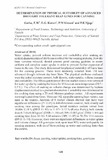Determination of physical suitabilty of advanced drought tolerant bean lines for canning

View/
Date
2011-09Author
Njage, P. K.
Kimani, P. M.
Karuri, E.G.
Gathu, E.W.
Language
enMetadata
Show full item recordAbstract
Water uptake, percent volume increase and cookability after soaking are
critical characteristics of dry beans destined for the canning industry. New dry
bean varieties released, should possess good canning qualities to ensure
uniform and complete water uptake in order to prevent further expansion of
beans in the can. This study determined the physical suitability of 8 new lines
for the canning process. These were randomly selected from 150 new
advanced drought tolerant dry bean lines. The physical attributes evaluated
were the initial moisture content, bulk density, water uptake, volume increase
and cookability. The 8 bean genotypes of diverse market classes were screened
for water uptake by soaking the beans for 16 hours at room temperature (20.5 ±
O.5"C). The effect of soaking on volume change was determined by heptane
displacement method in a graduated container. Cookability was determined by
the cooking time using a 25-well Mattson pindrop cooker. All experiments
were replicated three times. Mexican 142, a popular canning bean variety, was
used as the control. Analysis of 8 market classes showed that there were
significant differences (P< 0.05) in initial moisture content, bulk density and
cooking time among the genotypes. Initial moisture content varied from
1O.00± 0.10 % (DNB 11-10) to 11.87± 0.12 % (Kenya Early); bulk density
from 0.710±0.003 g/cm' (DNB 11-10) to 0.769± 0.003 g/cm' (DSS 11-04) and
cooking time from 30.31± 5.60 minutes (DPC 11-05) to 51.29± 13.6 minutes
(DNB 11-10). However, there were no significant differences in water uptake
and volume change. All genotypes took up at least 90% water and qualify for
canning purposes, with six of them picking up water and cooking faster than
the control.
Citation
Optimimization of Agricultural Value Chains for sustainable DevelopmentSponsorhip
National Council of Science and Technology, The Kenya Seed CompanyPublisher
Faculty of Agriculture, University of Nairobi
Description
Poster presentation in aGRO 2011Biennial Conference
